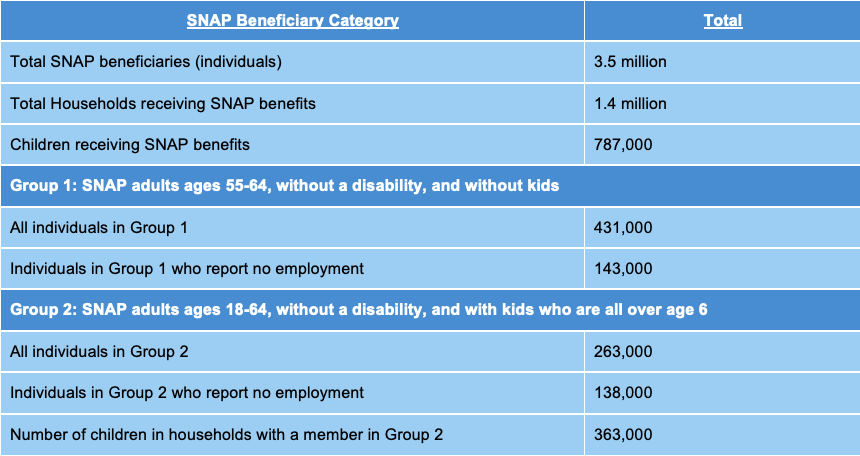Fact Sheet: SNAP Cuts in New York
June 6, 2025 |
Federal budget bill would have dramatic implications for New Yorkers’ food security
The “One Big Beautiful Bill Act” (OBBBA), passed by the House of Representatives on May 22, includes major cuts and revisions to food stamps, formally known as the “Supplemental Nutrition Assistance Program” (SNAP). These changes would have dramatic implications for New Yorkers’ food security.
3.5 million New Yorkers – 18 percent of the state population – depend on SNAP benefits, which average $209 per month for a participant (about $2,500 per year).[i] The OBBBA would threaten SNAP benefits for over 1 million New Yorkers, including 363,000 children.
New York will need to spend an additional $2.1 billion annually just to maintain current SNAP benefits.
- The OBBBA shifts 5-25 percent of benefit costs from the federal budget to state budgets.
- The precise amount of the cost-shift is determined by a state’s “payment error rate.” New York’s most recent payment error rate, while in line with the national average, would put it in the maximum cost-shift group of 25 percent.
- There is no guarantee that states will fill in the federal funding gaps; benefits may be significantly reduced if the funding gaps go un-filled.
The OBBBA imposes new work requirements on SNAP beneficiaries that will undermine food security for all — even those who still qualify.
- New work requirements for SNAP eligibility will immediately cause about 281,000 adults in New York to lose SNAP eligibility and another 413,000 to be at risk of losing eligibility.
- 363,000 children who live with these adults could subsequently lose access to SNAP benefits that they currently receive.
- Research shows thatwork requirements reduce SNAP participation even for those who remain eligible.
- Research also has shown that work requirements do not increase employment outcomes for SNAP participants.
The OBBBA permanently changes the “thrifty food plan” cost index calculation to permanently lower benefit levels for all participants.
- SNAP benefit growth will be capped at the inflation rate, even if the cost of groceries rises more than the overall average inflation rate. Other cost indicators, such as the cost of securing a healthy diet, will not be considered at all.
- This will cut benefits to all SNAP participants in the country by an estimated $35 billion over the next decade.
Summary of SNAP beneficiaries affected by work requirements
(Groups 1 and 2 will both face new works requirements under OBBBA)

Source: 2023 American Community Survey; FPI calculations
Sources
[i]https://www.cbpp.org/sites/default/files/atoms/files/snap_factsheet_new_york.pdf
Fact Sheet: SNAP Cuts in New York
June 6, 2025 |
Federal budget bill would have dramatic implications for New Yorkers’ food security
The “One Big Beautiful Bill Act” (OBBBA), passed by the House of Representatives on May 22, includes major cuts and revisions to food stamps, formally known as the “Supplemental Nutrition Assistance Program” (SNAP). These changes would have dramatic implications for New Yorkers’ food security.
3.5 million New Yorkers – 18 percent of the state population – depend on SNAP benefits, which average $209 per month for a participant (about $2,500 per year).[i] The OBBBA would threaten SNAP benefits for over 1 million New Yorkers, including 363,000 children.
New York will need to spend an additional $2.1 billion annually just to maintain current SNAP benefits.
- The OBBBA shifts 5-25 percent of benefit costs from the federal budget to state budgets.
- The precise amount of the cost-shift is determined by a state’s “payment error rate.” New York’s most recent payment error rate, while in line with the national average, would put it in the maximum cost-shift group of 25 percent.
- There is no guarantee that states will fill in the federal funding gaps; benefits may be significantly reduced if the funding gaps go un-filled.
The OBBBA imposes new work requirements on SNAP beneficiaries that will undermine food security for all — even those who still qualify.
- New work requirements for SNAP eligibility will immediately cause about 281,000 adults in New York to lose SNAP eligibility and another 413,000 to be at risk of losing eligibility.
- 363,000 children who live with these adults could subsequently lose access to SNAP benefits that they currently receive.
- Research shows thatwork requirements reduce SNAP participation even for those who remain eligible.
- Research also has shown that work requirements do not increase employment outcomes for SNAP participants.
The OBBBA permanently changes the “thrifty food plan” cost index calculation to permanently lower benefit levels for all participants.
- SNAP benefit growth will be capped at the inflation rate, even if the cost of groceries rises more than the overall average inflation rate. Other cost indicators, such as the cost of securing a healthy diet, will not be considered at all.
- This will cut benefits to all SNAP participants in the country by an estimated $35 billion over the next decade.
Summary of SNAP beneficiaries affected by work requirements
(Groups 1 and 2 will both face new works requirements under OBBBA)

Source: 2023 American Community Survey; FPI calculations
Sources
[i]https://www.cbpp.org/sites/default/files/atoms/files/snap_factsheet_new_york.pdf
